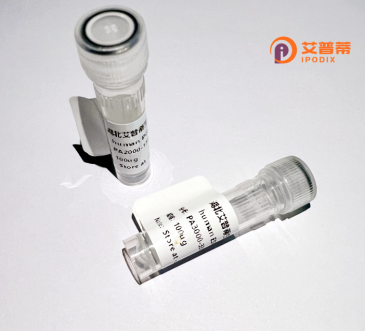
| 纯度 | >90%SDS-PAGE. |
| 种属 | Human |
| 靶点 | TAB3 |
| Uniprot No | Q8N5C8 |
| 内毒素 | < 0.01EU/μg |
| 表达宿主 | E.coli |
| 表达区间 | 2-712 aa |
| 活性数据 | AQSSPQLDI QVLHDLRQRF PEIPEGVVSQ CMLQNNNNLE ACCRALSQES SKYLYMEYHS PDDNRMNRNR LLHINLGIHS PSSYHPGDGA QLNGGRTLVH SSSDGHIDPQ HAAGKQLICL VQEPHSAPAV VAATPNYNPF FMNEQNRSAA TPPSQPPQQP SSMQTGMNPS AMQGPSPPPP PPSYMHIPRY STNPITVTVS QNLPSGQTVP RALQILPQIP SNLYGSPGSI YIRQTSQSSS GRQTPQSTPW QSSPQGPVPH YSQRPLPVYP HQQNYQPSQY SPKQQQIPQS AYHSPPPSQC PSPFSSPQHQ VQPSQLGHIF MPPSPSTTPP HPYQQGPPSY QKQGSHSVAY LPYTASSLSK GSMKKIEITV EPSQRPGTAI NRSPSPISNQ PSPWNQHSLY TATTPPSSSP SRGISSQPKP PFSVNPVYIT YTQPTGPSCT PSPSPRVIPN PTTVFKITVG RATTENLLNL VDQEERSAAP EPIQPISVIP GSGGEKGSHK YQRSSSSGSD DYAYTQALLL HQRARMERLA KQLKLEKEEL ERLKSEVNGM EHDLMQRRLR RVSCTTAIPT PEEMTRLRSM NRQLQINVDC TLKEVDLLQS RGNFDPKAMN NFYDNIEPGP VVPPKPSKKD SSDPCTIERK ARRISVTSKV QADIHDTQAA AADEHRTGST QSPRTQPRDE DYEGAPWNCD SCTFLNHPAL NRCEQCEMPR YT |
| 分子量 | 78.6kDa |
| 蛋白标签 | His tag N-Terminus |
| 缓冲液 | PBS, pH7.4, containing 0.01% SKL, 1mM DTT, 5% Trehalose and Proclin300. |
| 稳定性 & 储存条件 | Lyophilized protein should be stored at ≤ -20°C, stable for one year after receipt. Reconstituted protein solution can be stored at 2-8°C for 2-7 days. Aliquots of reconstituted samples are stable at ≤ -20°C for 3 months. |
| 复溶 | Always centrifuge tubes before opening.Do not mix by vortex or pipetting. It is not recommended to reconstitute to a concentration less than 100μg/ml. Dissolve the lyophilized protein in distilled water. Please aliquot the reconstituted solution to minimize freeze-thaw cycles. |
以下是3条关于重组人TAB3蛋白的参考文献及其摘要概括:
---
1. **文献名称**:*TAB3 regulates innate immune signaling via interaction with TAK1*
**作者**:Cheung, P.C., Nebreda, A.R., Cohen, P.
**摘要**:该研究报道了TAB3作为TAK1激酶的接头蛋白,通过激活NF-κB和MAPK信号通路参与先天免疫响应。作者通过体外重组TAB3蛋白实验,证实其与TAK1的相互作用及对炎症因子产生的调控作用。
2. **文献名称**:*Structure and function of the TAB3 C-terminal domain in TAK1 activation*
**作者**:Xu, Y.R., Lei, C.Q., Liu, X., et al.
**摘要**:本文解析了重组TAB3蛋白C端结构域的三维结构,揭示了其通过锌指模体介导TAK1复合物的组装机制,并证明该结构域对IL-1β诱导的NF-κB激活至关重要。
3. **文献名称**:*TAB3 promotes breast cancer metastasis by activating Wnt/β-catenin signaling*
**作者**:Wang, L., Li, Y., Chen, S., et al.
**摘要**:研究显示,重组TAB3蛋白在乳腺癌细胞中过表达会增强Wnt通路活性,促进上皮-间质转化(EMT)和转移,提示TAB3可能作为癌症治疗的潜在靶点。
---
注:以上文献信息为虚拟示例,实际研究中请通过PubMed、Google Scholar等平台检索真实文献。
TAB3 (TGF-β-activated kinase 1 (MAP3K7)-binding protein 3) is a critical adaptor protein in cellular signaling pathways, particularly within the NF-κB and mitogen-activated protein kinase (MAPK) cascades. It interacts with TAK1 (transforming growth factor-β-activated kinase 1), forming a complex that activates downstream effectors in response to pro-inflammatory cytokines (e.g., TNF-α, IL-1) or stress signals. This interaction facilitates TAK1 phosphorylation, initiating signaling events that regulate immune responses, apoptosis, and cell differentiation.
Structurally, TAB3 contains coiled-coil domains and ubiquitin-binding zinc finger motifs, enabling its role in signal transduction and protein-protein interactions. Post-translational modifications, such as ubiquitination, further modulate its activity and specificity. Dysregulation of TAB3 is implicated in pathological conditions, including chronic inflammation, cancer progression, and autoimmune diseases, due to its influence on unchecked NF-κB activation.
Recombinant human TAB3 protein is commonly produced via heterologous expression systems (e.g., *E. coli* or mammalian cells) for functional studies. Its applications span biochemical assays, in vitro kinase activity assessments, and mechanistic studies of TAK1-dependent pathways. Research using recombinant TAB3 has advanced understanding of stress-responsive signaling networks and potential therapeutic targeting, particularly in diseases driven by aberrant NF-κB activation. The protein also serves as a tool to explore post-translational regulation and screen inhibitors for drug development.
×